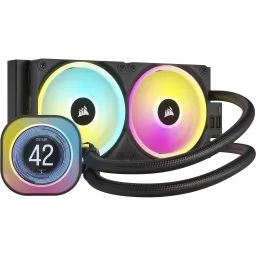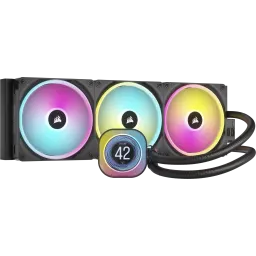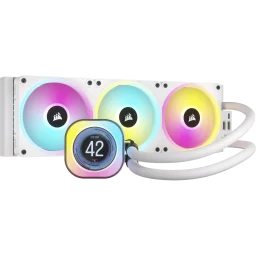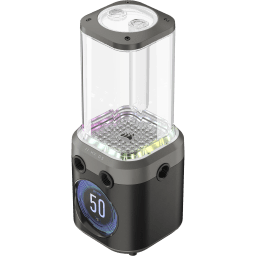BLOG
iCUE LINK devices in a 5000 & 7000 series case: Best way to route the cables
Corsair has revolutionized the way we build PC systems with their latest product, iCUE LINK. For years, building a PC has been considered a daunting and time-consuming task. However, with iCUE LINK, that assumption is a thing of the past.
In this article, we will demonstrate the simple process of routing and managing cables from various CORSAIR iCUE LINK-compatible devices using 5000 and 7000 series cases.

There are numerous reasons why PC enthusiasts should consider integrating iCUE LINK devices into their PC builds, regardless of their level of expertise. For instance, the ease of installation and the potential for future upgrades are two significant factors that can significantly impact the PC-building experience. We have provided a detailed breakdown of various reasons why someone should build an iCUE LINK system in this Explorer article.

CASE IN POINT
Building a PC can be an exciting experience, whether it's your first or 16th build. There's nothing quite like the satisfaction of seeing all the components working seamlessly the first time you power on the system, with all cables neatly managed and laid out. To achieve your ideal build, you need to follow a process. Firstly, you should select components that make the journey easier, such as choosing a case with features that aid cable management, like the CORSAIR 5000 and 7000 series cases.


5000D AIRFLOW White
7000D AIRFLOW Black
These cases are specifically designed to provide an enjoyable experience to PC builders while building their setup. With features like the RapidRoute Cable Management System, it has become easier to plan and route cables behind the motherboard tray, resulting in a clean and tidy look for your PC.
iCUE LINK DEVICES in a 5000 and 7000 series case
We all know that building a PC can be a lot of fun, and using the 5000 and 7000 series cases can make it even easier. But now, imagine how much simpler it will be if you use iCUE LINK devices in combination with these cases. It's like a dream come true for any PC builder! When you pair the iCUE LINK single cable system with the 5000 and 7000 RapidRoute Cable Management, you have everything you need for a seamless building experience.
5000D AIRFLOW BUILD
Let’s start with the 5000 case. In this section, we will be using a white 5000D AIRFLOW model.

It is quite apparent from this build that the internal design of the 5000 series case is exceptionally well-crafted. Despite being a mid-tower case, it has ample space to accommodate multiple fans, which aids in providing adequate airflow to keep your hardware cool. Moreover, the iCUE LINK QX RGB fans, which look great, enhances the overall appearance of your build.

As we mentioned at the beginning of this article, building a PC with iCUE LINK is much easier, thanks to its innovative cable system. The system uses only one connector for all iCUE LINK-compatible devices instead of a bunch of different cables, which often results in cable clutter, commonly known as the Rat’s Nest.
We organized the different iCUE LINK-compatible components used in this build into two groups, Group 1 and Group 2. Group 1 consists of six QX120 RGB fans, with three located at the front and another three on the side. For Group 2, we have the iCUE LINK H150i LCD AIO Liquid CPU Cooler and four QX120 RGB fans, with three mounted on the cooler's radiator and one on the rear of the case.

Let's review how the components within Group 1 are connected. The illustration below shows how the iCUE LINK cables are linked from the front fans to the side fans. The image on the right depicts the end of the chain. The iCUE LINK cable from the last fan, labeled fan 6, is connected to the iCUE LINK System Hub.

Let's take a closer look at how the components in Group 2 are connected. Group 2 comprises 4 QX120 RGB fans and 1 H150i LCD AIO cooler, making a total of 5 iCUE LINK devices. The connection of these devices starts from the left, which is the rear fan, then moves to the AIO cooler's distribution hub, further to the fans 2, 3, and 4 mounted on the radiator, and finally to the iCUE LINK Hub.


Here is an image for a more detailed look at how Group 2 devices are all connected to the H150i’s distribution hub.

Moving on to the backside of the system, which some people refer to as the "Darkside" due to the complexity of cable management. Without proper organization, cables can get lost in the void. However, with iCUE LINK, you can rest easy knowing that all your cables are well-managed. With many components in a build, cable management can be a time-consuming and challenging task. Proper routing of cables is essential to make the build look neat. iCUE LINK makes cable management much easier and saves time, making a significant difference for those who don't want to spend hours organizing the cables.
For a better visual representation of how iCUE LINK can impact your PC build, here's a comparison between two builds using the same case that have similar components installed.

Below, you can see that each of the two groups of components is only using one iCUE LINK cable. This is a significant improvement because there are a total of 10 fans in this build. Without iCUE LINK, you would need to manage 20 cables because each fan requires two cables: one for power and one for lighting (data). This number only includes the fans, not other devices like AIO coolers.
The Group 1 iCUE LINK cable should be plugged into one of the ports in the iCUE LINK System Hub, and the same applies to Group 2. It's important to remember that the iCUE LINK System Hub can support up to 14 iCUE LINK-compatible devices, with a maximum of 7 devices per channel. In this particular build, there are 6 components in Group 1, all of which are QX120 RGB fans.
There are two connectors in the iCUE LINK System Hub: a PCIe power connector to connect to your power supply and a USB-C connector to connect to your motherboard's USB header.

To power the iCUE LINK System Hub, connect the PCIe Power Adapter to your PSU's PCIe Connector. Then, connect the USB-C cable from the iCUE LINK System Hub and the iCUE LINK LCD Screen Module to a Y-Splitter USB cable. Finally, connect the Y-Splitter USB cable to the motherboard's USB internal header.

That was a pretty easy task that required minimal effort, in my opinion. This particular PC build consists of 11 iCUE LINK devices, which means you only have to manage a total of 5 cables instead of 20 or more if you don't have iCUE LINK.

For the iCUE LINK 7000 case build, we went one step further by installing Hydro X custom water cooling components and increasing the number of iCUE LINK-compatible devices and groups. This was done to demonstrate the flexibility of the iCUE LINK Ecosystem.
In the image below, you can see that the 7000D AirFlow case is similar to its smaller version, the 5000D Airflow, when it comes to the internal layout. Both cases come equipped with the CORSAIR RapidRoute Cable Management System and side fan mounts positioned next to the MB tray, which allows for maximum airflow. In terms of features, both cases are quite similar, with the main difference being the size. The 7000D Airflow is a full-tower case that offers more space for internal components and allows for better cable management and cooling options, making it the ideal choice for building a high-performance PC.

There are 14 iCUE LINK-compatible devices for this build, grouped into 5 groups.
Group 1: 7 Devices
- 3x QX140 RGB Fans in the front
- 4x QX120 RGB Fans
Group 2: 4 Devices
- 4x QX120 RGB Fans
Group 3: 1 Device
Group 4: 1 Device
Group 5: 1 Device
Before we dive into the specifics of this build, be sure to check out CORSAIR's Custom Cooling Configurator. It will help guide you through the process of building a custom water-cooled PC.

It might seem like managing the cables for a build with 14 iCUE LIN LINK devices would be more complicated than the 5000 build. However, it's actually more straightforward for this setup. This is because groups 3, 4, and 5 are directly connected to the iCUE LINK 4-Way Splitter, which simplifies the cable management process. The fans in groups 1 and 2 are daisy-chained within their groups. Group 1 is directly connected to the iCUE LINK System Hub, and Group 2 is connected to the iCUE LINK 4-Way Splitter.
As you can see, the iCUE LINK 4-Way Signal Splitter is a part of this build. We added it to avoid the cable clutter that would result from daisy-chaining the Hydro X components with the other iCUE LINK devices. This splitter has four iCUE LINK device ports that can be connected directly to an iCUE LINK System Hub, providing more flexibility in device placement. This makes it perfect for custom water cooling systems.

The iCUE LINK Ecosystem in this image is on full display. Now, that’s what you called immaculate cable management. Oh, and by the way, this type of cable management you see here wouldn’t be possible without the CORSAIR RMx SHIFT PSU. Having your PSU cables come out from the side like the RMx SHIFT is a godsend when it comes to cable management. Instead of routing the cables from the inside, where space can be very limited, you access them from the side – a total game changer.

Cable management for your PC is all about getting the cables that connect the various components organized and tidy. It might seem like a big task because of the limited space, different types of cables and components, and the need for both functionality and good looks. Plus, it takes a bit of practice to get it right. But, with some smart planning, the right tools, and some iCUE LINK components, you can have a well-organized and efficient cable layout.
At CORSAIR, our main goal is to make PC building easy and fun for everyone, whether you're a newbie or a seasoned pro who values your time. That's why we created the iCUE LINK Ecosystem - to save you from the hassle of dealing with cables and let you spend more time doing what you love, like gaming, creating content, streaming, and more. So, no more wasting precious hours on cable management - now you can focus on the fun stuff!
Since announcing iCUE LINK Technology in June 2023, CORSAIR has introduced several iCUE LINK-compatible products to the PC DIY market for users to take advantage of its benefits. You can check all iCUE LINK-compatible devices on our official website.
A CIKKBEN SZEREPLŐ TERMÉKEK























